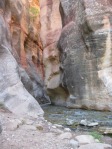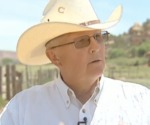Browsing All Posts filed under »Water«
The Elephant in the Room is a Cow — Grazing Impacts on So. Utah Forests
My wife and I are both sixth generation Utahns. We own homes in both Salt Lake and Wayne counties. We were married in the Capitol Reef National Park outdoor amphitheater in 2010. Together we cherish the natural landscape of Utah, our pretty, great state. Except for one thing. We have become sensitized to the damage […]
Beaver and Goats
March 12, 2014
 Spring is here and my wife, Kirsten, and I are poking our heads out more and looking into environmental issues. In fact, it has felt like March in Utah since early February and it is good to get out. In addition my son, Nick, has been interning for Wild Utah Project and WildEarth Guardians, both environmental agencies. Kirsten hiked the Calf Creek Falls trail on Monday with her sister and two nephews strapped to their backs. Nick made a run down to Moab a couple of weeks ago to visit with the Forest Service, Wild Utah Project and the Grand Canyon Trust about exotic mountain goats recently plunked down on the La Sals. [ . . . more]
Spring is here and my wife, Kirsten, and I are poking our heads out more and looking into environmental issues. In fact, it has felt like March in Utah since early February and it is good to get out. In addition my son, Nick, has been interning for Wild Utah Project and WildEarth Guardians, both environmental agencies. Kirsten hiked the Calf Creek Falls trail on Monday with her sister and two nephews strapped to their backs. Nick made a run down to Moab a couple of weeks ago to visit with the Forest Service, Wild Utah Project and the Grand Canyon Trust about exotic mountain goats recently plunked down on the La Sals. [ . . . more]
What uses most of the land and water without showing up in production?
February 6, 2012
 70% of the land in Utah is public. And 70% of that land is handed out for grazing. Over 80% of the water used in Utah is for agriculture and most of that is to grow hay for livestock. That is a lot of land and water. Open this chart on the left of the State of Utah Governor Gary R. Herbert Economic Report's figures on employment by industry as a percent of total employment: Dec. 2011. Where's agriculture? The subsidized use of all that land and water isn't producing much, particularly jobs.
70% of the land in Utah is public. And 70% of that land is handed out for grazing. Over 80% of the water used in Utah is for agriculture and most of that is to grow hay for livestock. That is a lot of land and water. Open this chart on the left of the State of Utah Governor Gary R. Herbert Economic Report's figures on employment by industry as a percent of total employment: Dec. 2011. Where's agriculture? The subsidized use of all that land and water isn't producing much, particularly jobs.
Ed Firmage lets the good old boys have it.
January 22, 2012
In response to an article in the Salt Lake Tribune announcing that Utah State Engineer Kent Jones OK’d the use of Green River water to cool a proposed nuclear reactor, Ed Firmage Jr. posted a polished reply. Click title to see more.
Failure of Land Use Socialism
January 4, 2012
 There is nothing more harmful to the arid lands of the American West today than public land grazing. It is ironic that the Cato Institute, the leading libertarian, conservative think tank calls the results of over a century of grazing on public lands, " . . . a testimony to the failure of land-use socialism." Ouch. 70% of the over 300 million acres of public land in the West is grazed, producing less than 3% of the nation's beef. Agriculture is less than 1% of the western economies but uses nearly 80% of the water, much of that used to grow hay for to feed livestock. Ranching is a tiny little special interest. A rancher pays $1.35 per month to graze a cow and its calf. How much do you suppose it costs to feed a gerbil for a month? Yet the BLM, with $40 million of taxpayer stimulus money, wants to ignore the impact of grazing in their Rapid Ecoregional Assessments project to map ecological trends throughout the West. See more here . . . >>
There is nothing more harmful to the arid lands of the American West today than public land grazing. It is ironic that the Cato Institute, the leading libertarian, conservative think tank calls the results of over a century of grazing on public lands, " . . . a testimony to the failure of land-use socialism." Ouch. 70% of the over 300 million acres of public land in the West is grazed, producing less than 3% of the nation's beef. Agriculture is less than 1% of the western economies but uses nearly 80% of the water, much of that used to grow hay for to feed livestock. Ranching is a tiny little special interest. A rancher pays $1.35 per month to graze a cow and its calf. How much do you suppose it costs to feed a gerbil for a month? Yet the BLM, with $40 million of taxpayer stimulus money, wants to ignore the impact of grazing in their Rapid Ecoregional Assessments project to map ecological trends throughout the West. See more here . . . >>
American Drinking Water Gets a D-. Republicans want it to get an F.
December 9, 2011
 "Bipartisan analyses have repeatedly shown that the cost of environmental regulation is exponentially cheaper than the costs of toxic cleanup and medical care." And yet the fearful shriek that environmental regulation "kills jobs" while the hamstrung EPA can't even adequately test or develop standards for two-thirds of the pollutants detected in water. Enough already. . . . more>>
"Bipartisan analyses have repeatedly shown that the cost of environmental regulation is exponentially cheaper than the costs of toxic cleanup and medical care." And yet the fearful shriek that environmental regulation "kills jobs" while the hamstrung EPA can't even adequately test or develop standards for two-thirds of the pollutants detected in water. Enough already. . . . more>>
Our River Run Dry
November 18, 2011
 The Colorado River does not make it to the sea. It's all used up 70 miles before it gets there, leaving the Colorado River Delta parched. Over 75 percent of the water extracted goes to agriculture. Whenever something about water use comes up in the press, watering lawns always comes up. That is the wrong grass. It's not lawns draining the river, it's hay. Buying up the virtual property right of water rights from farmers and ranchers is called "water ranching." I'll try to find more on that in the future. In the meanwhile, here's a piece from the New York Times on the river, and another interesting blog from a recent author on the subject, Jonathan Waterman (great name.)
The Colorado River does not make it to the sea. It's all used up 70 miles before it gets there, leaving the Colorado River Delta parched. Over 75 percent of the water extracted goes to agriculture. Whenever something about water use comes up in the press, watering lawns always comes up. That is the wrong grass. It's not lawns draining the river, it's hay. Buying up the virtual property right of water rights from farmers and ranchers is called "water ranching." I'll try to find more on that in the future. In the meanwhile, here's a piece from the New York Times on the river, and another interesting blog from a recent author on the subject, Jonathan Waterman (great name.)
They are dry in the mouth too.
October 10, 2011
 Just like the Colorado River does not make it to the Colorado River Delta and on to the sea, Australia's largest river, the Murray-Darling is dry in the mouth. A 10 year drought there has made for necessary changes. Brad Udall, director of the Western Water Assessment in Colorado, spent four months in Australia working with its Department of Water. Cally Carswell of High Country News explores with Udall what happens when the door is opened and more than special interests and lawyers are allowed in the room to talk about solutions. Udall says, "For 150 years, we’ve had three kinds of people in the room talking about water: we’ve had water users, we’ve had attorneys and we’ve had engineers. And for the most part, the public, economists and scientists have not been a part of this dialogue. In Australia, they don’t even let attorneys in the room — at least according to one gentlemen down there — when it comes to water. And they talk in these very holistic (terms): what’s good for our economy, what’s good for our social systems, what’s good for the environment — they have those three perspectives. It’s not just driven by the legal system, which is usually almost always the case here in Colorado." . . . more>>
Just like the Colorado River does not make it to the Colorado River Delta and on to the sea, Australia's largest river, the Murray-Darling is dry in the mouth. A 10 year drought there has made for necessary changes. Brad Udall, director of the Western Water Assessment in Colorado, spent four months in Australia working with its Department of Water. Cally Carswell of High Country News explores with Udall what happens when the door is opened and more than special interests and lawyers are allowed in the room to talk about solutions. Udall says, "For 150 years, we’ve had three kinds of people in the room talking about water: we’ve had water users, we’ve had attorneys and we’ve had engineers. And for the most part, the public, economists and scientists have not been a part of this dialogue. In Australia, they don’t even let attorneys in the room — at least according to one gentlemen down there — when it comes to water. And they talk in these very holistic (terms): what’s good for our economy, what’s good for our social systems, what’s good for the environment — they have those three perspectives. It’s not just driven by the legal system, which is usually almost always the case here in Colorado." . . . more>>
Only one stream in Utah is wild and scenic?
October 7, 2011
 Above all Utah is a wild and scenic place. Yet only one segment of one river in the state has been granted protection. There may be hope. Segments of nine rivers and streams in southwest Utah have been deemed eligible by the Bureau of Land Management for possible protection under the Wild and Scenic Rivers Act. Zach Frankel, executive director of the Utah Rivers Council, said getting rivers or sections of streams designated as wild and scenic is difficult because of the required congressional approval. Frankel said his group has been identifying rivers for designation throughout Utah, but a congressional sponsor is needed and no one has shown much passion. Why the lack of concern? . . . more>>
Above all Utah is a wild and scenic place. Yet only one segment of one river in the state has been granted protection. There may be hope. Segments of nine rivers and streams in southwest Utah have been deemed eligible by the Bureau of Land Management for possible protection under the Wild and Scenic Rivers Act. Zach Frankel, executive director of the Utah Rivers Council, said getting rivers or sections of streams designated as wild and scenic is difficult because of the required congressional approval. Frankel said his group has been identifying rivers for designation throughout Utah, but a congressional sponsor is needed and no one has shown much passion. Why the lack of concern? . . . more>>Ranchers wearing Tevas!
October 6, 2011
 Earlier I made a post referring to an article about grazing and land management in the Los Angeles Times. Now here is one from The Atlantic, featuring 21st century ranchers, one even wearing Tevas. Tevas on a Suburu driving rancher is not something you see every day. The Atlantic has picked up on the critical idea that managing range land to optimize grass growth can make a significant impact on global carbon sequestration. It's good to see that deceptively benign appearing grazing practices are being seen in the national press as a globally important issue. But, once again, it is the local "way of life" that stands in the way. Can Wall Street actually help? . . . more>>
Earlier I made a post referring to an article about grazing and land management in the Los Angeles Times. Now here is one from The Atlantic, featuring 21st century ranchers, one even wearing Tevas. Tevas on a Suburu driving rancher is not something you see every day. The Atlantic has picked up on the critical idea that managing range land to optimize grass growth can make a significant impact on global carbon sequestration. It's good to see that deceptively benign appearing grazing practices are being seen in the national press as a globally important issue. But, once again, it is the local "way of life" that stands in the way. Can Wall Street actually help? . . . more>>
Colorado is watching the water in streams with real money
October 3, 2011
 Over 60 percent of the Colorado River's native flows are permanently removed at its headwaters by urban water systems, according to Colorado Trout Unlimited, and now two proposed water projects for Denver and the Front Range could take another 20 percent if enacted. The threatened Fraser River is a main tributary of the Colorado. It starts at Berthoud Pass, flowing for 32.5 miles — 19.5 miles in protected U.S. Forest Service and Bureau of Land Management lands — past Winter Park to Granby, Colorado. In 1992 Colorado voters overwhelmingly approved Great Outdoors Colorado (GOCO) to receive up to 50 percent of Colorado Lottery proceeds and use the funds on projects that protect and enhance Colorado's parks, wildlife, trails, rivers and open space, and more than 5 million people by last year. We can watch how that money is used to speak for the value of water in streams. . . . more>>
Over 60 percent of the Colorado River's native flows are permanently removed at its headwaters by urban water systems, according to Colorado Trout Unlimited, and now two proposed water projects for Denver and the Front Range could take another 20 percent if enacted. The threatened Fraser River is a main tributary of the Colorado. It starts at Berthoud Pass, flowing for 32.5 miles — 19.5 miles in protected U.S. Forest Service and Bureau of Land Management lands — past Winter Park to Granby, Colorado. In 1992 Colorado voters overwhelmingly approved Great Outdoors Colorado (GOCO) to receive up to 50 percent of Colorado Lottery proceeds and use the funds on projects that protect and enhance Colorado's parks, wildlife, trails, rivers and open space, and more than 5 million people by last year. We can watch how that money is used to speak for the value of water in streams. . . . more>>
Conservative Utah Lawmakers Espousing More Debt and More Taxes
September 21, 2011
 The water managers have already paid themselves $25 million studying the Lake Powell Pipeline. The project cost is going over estimates. There are other ways to get and save water. One must ask, who benefits the most here? . . . more>>
The water managers have already paid themselves $25 million studying the Lake Powell Pipeline. The project cost is going over estimates. There are other ways to get and save water. One must ask, who benefits the most here? . . . more>>


September 23, 2014
0